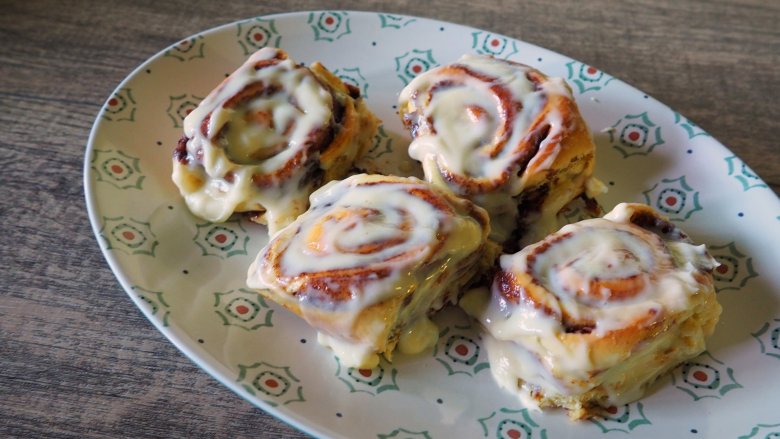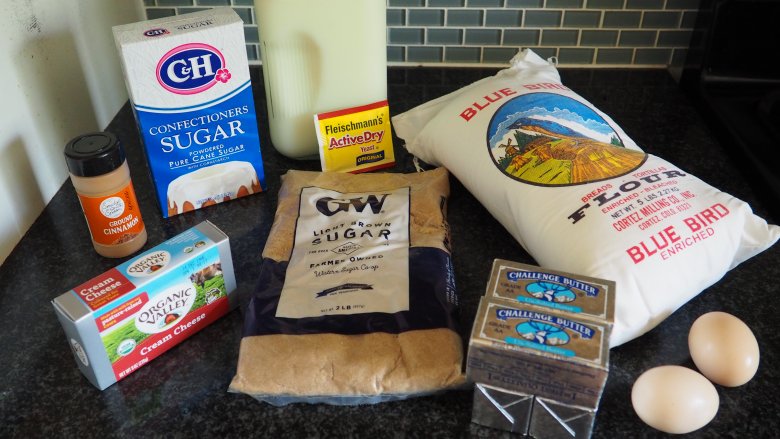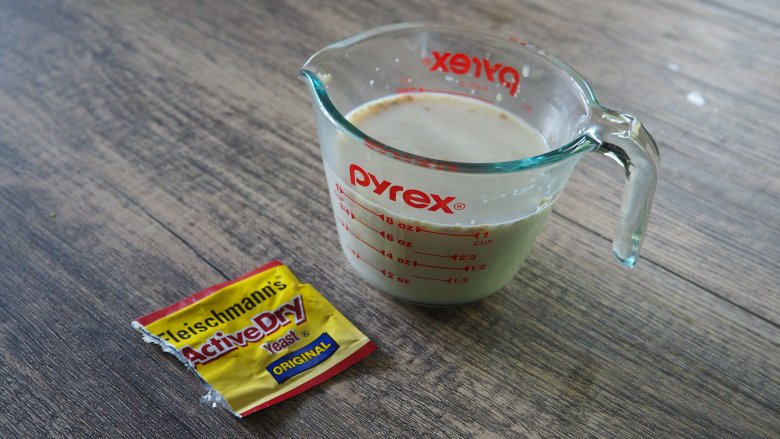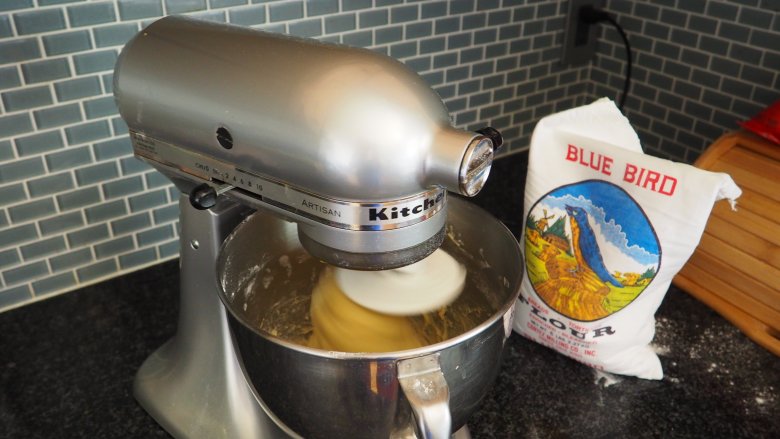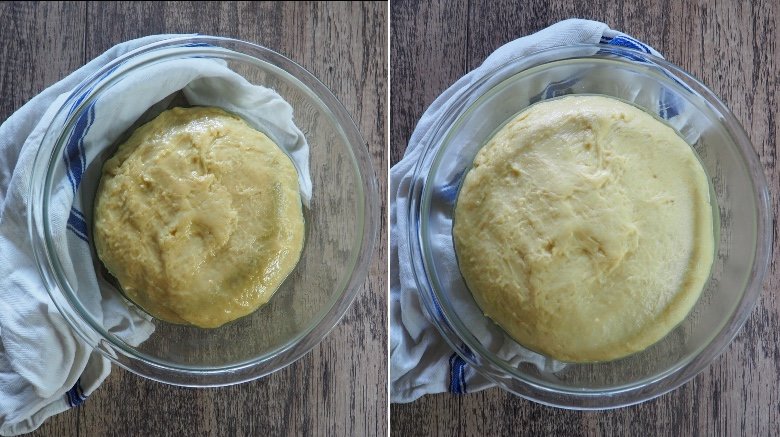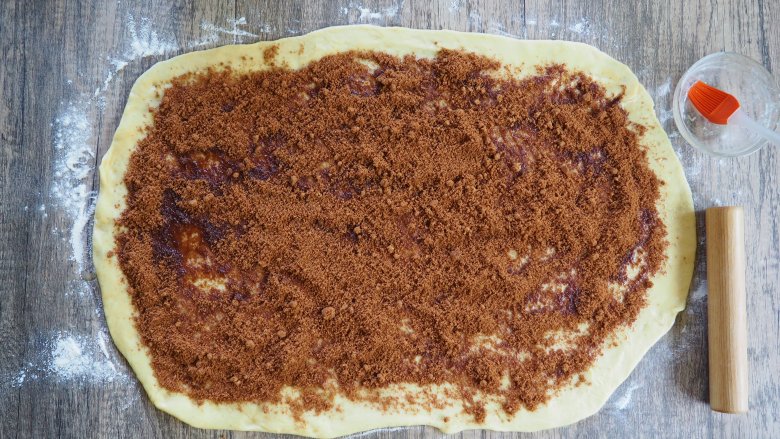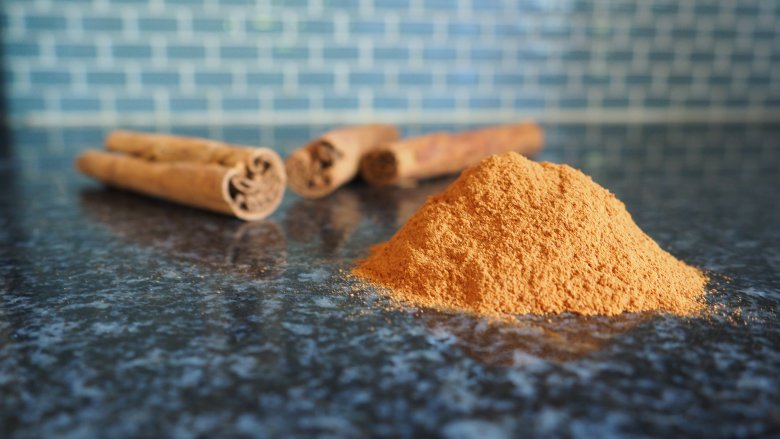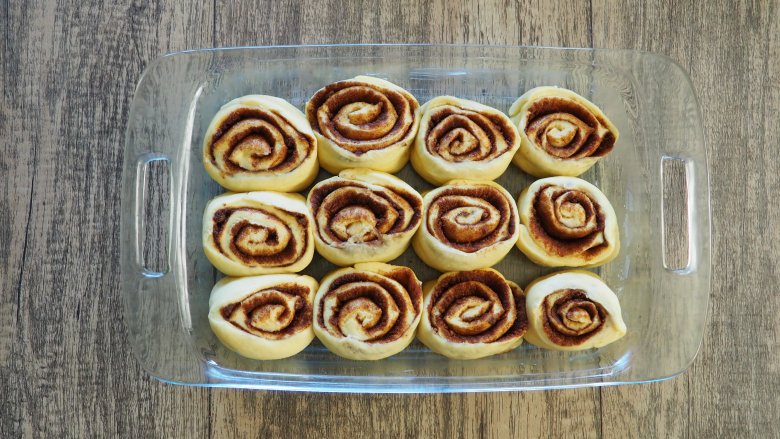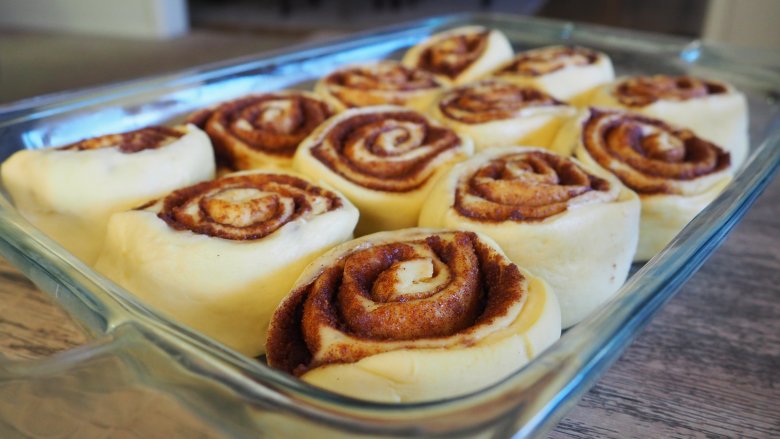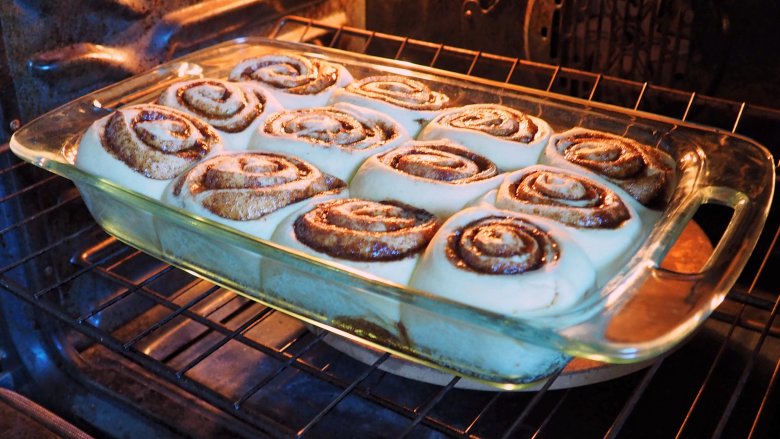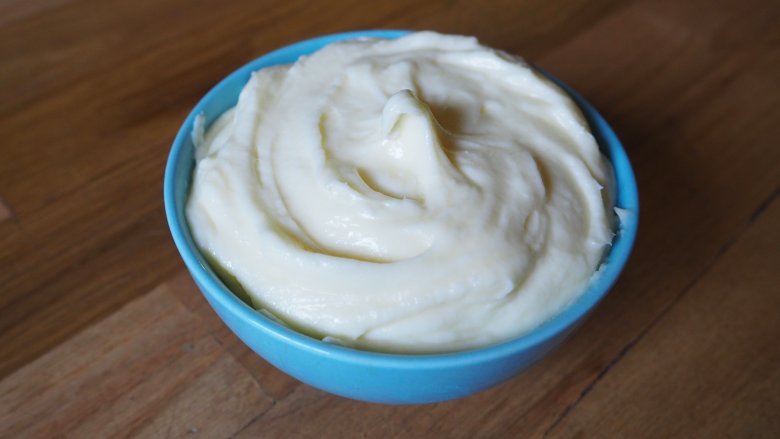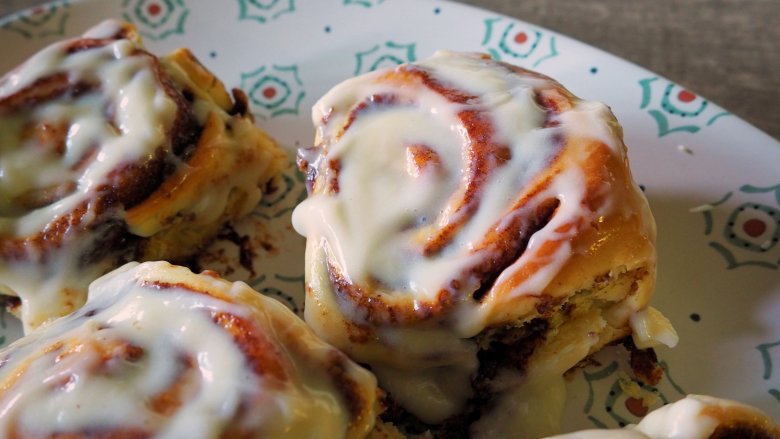Copycat Cinnabon Cinnamon Roll Recipe
We may receive a commission on purchases made from links.
We have a confession to make: Cinnabon gets us every time. It doesn't matter if we're still stuffed from lunch or we've given up sugar and sweets. As soon as we walk into the mall, the intoxicating aroma of butter and cinnamon assaults us from the corner Cinnabon store. We're drooling, starving, and absolutely have to grab one. Cinnabon's classic cinnamon buns are impossible to resist, and they haven't changed the recipe for 32 years. It's one of those things that just works.
There's a reason why Cinnabon's cinnamon rolls are so delicious: They've mastered the art of creating a soft, tender dough. Not to mention the sweet, cinnamony filling that's so intensely flavorful, you can't stop yourself from going in for another bite. And that messy, ooey, gooey cream cheese frosting? We can't even! Although it seemed impossible to recreate such perfection, we had to try. We figured out the best Cinnabon cinnamon rolls copycat recipe, and made it in our test kitchen. How did it stack up against the original? Let's find out.
Pick up the ingredients for your copycat Cinnabon cinnamon rolls
These cinnamon rolls require surprisingly few ingredients, especially considering they have three components: the dough, the filling, and the icing on top. All you really need is all-purpose flour, butter, eggs, milk, active dry yeast, cinnamon, cream cheese, and a few different kinds of sugar (granulated, brown, and confectioners). At the end of this article, you'll find the full ingredients list (including the measurements) along with the step-by-step directions.
While you don't need a stand mixer to make this recipe happen, it certainly makes life easier. The dough is extremely sticky, so it's much easier to knead using a dough hook. And when it comes to the frosting, it's almost impossible to make it as fluffy as Cinnabon's without the whisk attachment, too. Other than that, you'll need a few sizes of mixing bowls, a rolling pin, a 13x9 casserole dish, and a few hours to hang out while the rolls rise.
Start by activating the yeast for your copycat Cinnabon cinnamon rolls
Part of what makes these rolls so tasty is their fluffy texture and the pull-apart layers that are so tender, they almost melt in your mouth. How does Cinnabon pull it off? It's all about the yeast, a living organism that feeds on the sugars found in flour. It's important to activate yeast first, a process that basically wakes it up from its dried state and gets it ready to go. Temperatures between 105 and 115 degrees Fahrenheit are just about perfect; cooler temps won't get the job done, and hotter temperatures can kill the yeast.
Since yeast is a living organism, it's important to check those "best-by" dates. Otherwise, the yeast might be dead — even if you haven't opened the package. Dead yeast won't rise correctly, and the dough won't turn out fluffy. So, this step of combining the yeast with warm milk accomplishes two goals: wake up the yeast, and make sure the product is active. If the yeast doesn't froth up after a few minutes in the milk, toss it out and start again with a new packet. It's not worth getting to the end and having rolls that don't rise, wasting all the rest of the ingredients.
Use a stand mixer to create the dough for your copycat Cinnabon cinnamon rolls
When Cinnabon was developing its recipe in 1985, they went through hundreds of versions to find a dough that was both "pillowy and able to hold its shape" (according to the Seattle Met). It's all about mixing the ingredients for the perfect amount of time to activate the gluten network. The Spruce Eats describes how overworking the dough can make it tough. Underwork it, though, and it will lack the strength to hold together.
We knew we wanted to use a stand mixer with a dough hook attachment. The dough was way too sticky to knead by hand — it stuck badly to our hands when we tried — and it's always faster to knead with a machine. So, we added the milk-yeast mixture to the bowl along with the sugar, butter, eggs, salt, and the flour. Somewhere between five and eight minutes on medium speed, the dough looked perfect: It pulled away from the sides of the bowl and formed a soft, sticky ball around the dough hook.
Then, let the copycat Cinnabon cinnamon rolls dough rise for an hour
From here, we were ready for the yeast to do its magic and help the dough expand until it had doubled in size. After coating the dough ball in canola oil to keep it from sticking to the bowl, we covered the dough with a clean kitchen towel and set it in the warmest part of our kitchen. Warm temperatures are necessary here to help the yeast stay active. If your kitchen is cold and the dough doesn't rise within an hour, you can use the Cook's Illustrated technique of placing the bowl in the oven with three cups of boiling water to create the necessary heat.
Why is this time-consuming step so important? It gives the yeast time to feed and...well, burp. According to Taste of Home, as the yeast consumes sugar, it puts off carbon dioxide. The gasses get trapped in the gluten network you developed kneading the bread, causing the dough to rise and expand.
It's time to roll the copycat Cinnabon dough into a large rectangle
Okay, now comes the fun part. When the dough has doubled in size, you can punch it down and turn it out onto a lightly floured work surface. Then, roll it out into a 16- by 21-inch rectangle. It's such a specific size that we actually pulled out a ruler to make sure we got it right. It's not absolutely critical that you form a perfect rectangle, but you want to get it as close as possible. When you're done, the dough should be about 1/4-inch thick.
From here, you can spread the softened butter over the surface of the dough. You'll want it to be just soft enough to be spreadable, but not quite melted. Then, sprinkle on the filling mixture of brown sugar and cinnamon and roll the dough up. As it bakes, the filling ingredients will meld together and turn into syrupy goodness.
You'll end up forming a very long roll, so take your time and work one side at a time. Don't worry about rolling it a super tight because it'll have time to rise and fill in the cracks. After you have your cinnamon roll log, cut it into 12 even slices. If you're as much of a perfectionist as we are, you can use that ruler again to make sure each slice measures exactly 1-3/4 inches.
Cinnabun's rolls taste so good because of the cinnamon
If there's a secret ingredient in Cinnabun's cinnamon rolls, it's the cinnamon. You might be thinking that three tablespoons of cinnamon is way too much for this recipe, but trust us; it's just the right amount. It's not just about the quantity of cinnamon, either; the type of cinnamon you choose is just as important. Bon Appetit reports that the team creating the now-famous recipe tested cinnamon from every growing region in the world. The one from the Korintjie region of West Sumatra in Indonesia was more pungent tasting than other types, creating a perfect balance against the sweet brown sugar. It not only tastes better, but they thought it smelled better, too.
If you really want to make rolls that taste identical to Cinnabon's, you'll want to pick up a jar of their trademarked cinnamon, which they call Makara. It's the best way to recreate the filling Seattle Met calls "goo:" the sticky, sweet, syrupy filling made from butter, cinnamon, and brown sugar.
You can let your copycat Cinnabon cinnamon rolls rise in the refrigerator overnight
These rolls are definitely a labor of love. Although they only take about 20 minutes of hands-on prep time, you'll have to sit around and wait two hours for them to rise and rise again. Wouldn't it be great if you could pop a baking dish of prepared rolls into the refrigerator, ready to bake in the morning? As luck would have it, you can do just that.
The Girl Who Ate Everything confirms that you can make them the night before and let them rise while you're asleep. In the morning, they'll be ready to bake in the oven. If you happen to live in a hot area, you'll want to store them in the refrigerator overnight and let the dish come to room temperature before baking it. But, if it's the middle of winter and your house isn't too warm, they can rise on the counter overnight, covered with a clean kitchen towel.
Or, freeze them and cook them later
If you have the freezer space and you're a plan-ahead type of person, you can totally put an entire baking dish of ready-to-bake rolls in the freezer. Jo Cooks suggests wrapping the pan in two layers of plastic wrap to prevent the rolls from getting freezer burned. They'll keep for about six weeks in the freezer. To bake them, let them thaw in the refrigerator before following the rest of the baking steps.
If you don't want to sacrifice your casserole dish to the freezer for such a long period of time, you can always freeze the rolls after they're already baked. Cinnabon has confirmed that you can freeze their rolls for up to 30 days. When you're ready to eat, simply thaw them before reheating them in the microwave — 20 to 25 seconds should do the trick.
Preheat the oven and bake the copycat Cinnabon cinnamon rolls
You've waited for hours and hours for this moment, and it's finally here! It's time to preheat the oven to 350 degrees Fahrenheit and get baking. If you stored the baking dish in the freezer or refrigerator, make sure to let it come to room temperature before putting it in a hot oven. This is especially important for glass casserole dishes, which can shatter when exposed to sudden temperature changes.
Some copycat Cinnabon cinnamon rolls recipes called for baking the rolls for 15 minutes, but we found that 20 to 25 minutes was the sweet spot in our oven. Cinnabon cooks their rolls so they're slightly doughy in the middle — a temperature that Seattle Met describes as "medium rare to even rare." After 15 minutes, the "rare" dough was a little too doughy for our liking, but 25 minutes was perfect. That amount of time allowed the outside to get nice and golden brown while still keeping the inside moist.
It's all about Cinnabon's signature cream cheese frosting
Cinnabon's cream cheese frosting is legendary: "often been imitated but never replicated." So we definitely felt the pressure of putting this part of the recipe together. At first, we thought the amount of frosting we prepared was overkill. Then, we read a Business Insider report that each store goes through 275 pounds of frosting each day, and we felt a little bit better about it.
There are a few keys to getting the frosting just right. First, we found it tasted better and coated the rolls better when it was at room temperature. It's pretty easy to make it while you're waiting for the rolls to bake, beating the softened butter, cream cheese, vanilla, salt, and confectioners' sugar together in the stand mixer. If you prefer to make it in advance, be sure to pull it out of the fridge so it has time to warm up a little.
The second secret is to frost the rolls with half the frosting right after they come out of the oven. The frosting melts almost immediately and makes its way down into all the cracks and crevices. Then, when the rolls cool, add the remaining half of the cream cheese frosting to get the iced look.
How close did we get to Cinnabon cinnamon rolls?
Okay, when it comes to presentation, Cinnabon definitely wins. They have a special rack that separates the cinnamon rolls in the baking pan. We packed ours too tightly, so they baked into each other. That wasn't a problem for taste and flavor. What it did was make it super difficult to get the individual rolls out of the pan without destroying the roll next to it. Lesson learned.
The other thing we'll say is that it was a mistake to buy budget cinnamon. Our rolls tasted good, but they were missing Cinnabon's in-your-face, bold flavor. Now that we've done a side-by-side taste test, we totally understand why they only use their signature Makara cinnamon. We could absolutely taste the difference in our generic brand cinnamon, so next time we'll splurge for the good stuff.
Other than those minor complaints, these buns were fantastic. The dough was soft and pillowy, and the rolling process created layers that pulled apart from each other. The filling was rich and syrupy (even though it wasn't cinnamony enough). And the verdict on the "never replicated" frosting? We're pretty proud of ourselves because we nailed it. All in all, this recipe does a fantastic job of replicating this tasty treat.
Copycat Cinnabon cinnamon rolls directions
Although it seemed impossible to recreate Cinnabon's cinnamon rolls, we had to try. We figured out the best Cinnabon cinnamon rolls copycat recipe.
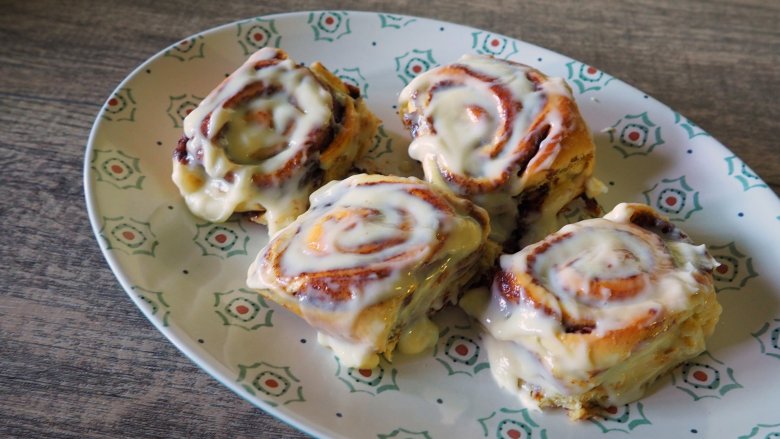
Ingredients
- 1 package (2-1/4 teaspoons) active dry yeast
- 1 cup warm whole milk, heated between 105 to 115 degrees Fahrenheit
- 1/2 cup granulated sugar
- 1/3 cup unsalted butter, melted
- 5/6 cup unsalted butter, softened
- 2 large eggs
- 1 and 1/8 teaspoon kosher salt
- 4 to 4-1/2 cups all-purpose flour
- 1 cup packed brown sugar
- 3 tablespoons ground cinnamon
- 8 oz cream cheese, softened
- 1 teaspoon vanilla extract
- 3 cups confectioners' sugar
Directions
- Heat the milk in the microwave or over low heat on the stovetop. When it reaches 105 to 115 degrees Fahrenheit, add the yeast and stir to combine. If the milk gets hotter than 115 degrees, allow it to cool before adding the yeast. Let the mixture sit for 5 minutes to activate the yeast.
- In the bowl of a stand mixer, combine the milk-yeast mixture with the granulated sugar, 1/3 cup of melted butter, eggs, 1 teaspoon salt, and 4 cups of flour. If you don't have a stand mixer, you can use a large bowl and mix the dough with a spoon.
- Using the dough hook attachment, mix the dough on medium speed for 5 to 8 minutes, adding additional flour if the dough does not form into a soft, sticky ball after the first minute.
- Transfer the dough to a greased bowl, turning it once to coat the ball on all sides. Cover the bowl with a clean kitchen towel and let it rise until doubled in size, about an hour.
- Meanwhile, in a small bowl, mix the brown sugar and cinnamon. Set aside.
- When the dough has doubled in size, punch it down and turn it out onto a lightly floured work surface. Roll it into a 16- by 21-inch rectangle that's about 1/4 inch thick.
- Brush the dough with 1/3 cup of softened butter. It needs to be really soft — but not melted — to spread properly. Then, sprinkle the brown sugar-cinnamon mixture evenly over the dough. Leave a 1/2 inch space at the top edge.
- Roll the dough up starting with the long side and pinch the seam to seal it. With the seam-side down, cut the roll into 12 even slices.
- Place each slice on a greased 13x9 casserole dish. If you are baking them now, cover the dish with a clean kitchen towel and let the rolls rise until they have doubled in size, about an hour. If you prefer to bake them later, cover the dish with plastic wrap and store them in the refrigerator overnight. In the morning, remove them from the refrigerator and let them come to room temperature.
- After the rolls have risen, you can also freeze them for as long as six weeks. Before baking the frozen rolls, let them thaw overnight in the refrigerator.
- Preheat the oven to 350 degrees.
- Bake the rolls until it they're cooked through and golden brown, about 20 to 25 minutes.
- While the rolls are baking, prepare the cream cheese frosting by beating the 1/2 cup of unsalted butter, cream cheese, vanilla, and 1/8 teaspoon of salt until well blended. Add the confectioners' sugar one cup at a time, beating until the frosting becomes thick and well incorporated.
- Frost the rolls with half of the cream cheese frosting while they're still hot in the pan. After they cool, add the remaining half of the cream cheese frosting.
- Carefully remove the rolls from the baking dish and serve immediately. Any leftovers can be refrigerated for a day or two. The rolls can be frozen for up to 30 days.
Nutrition
| Calories per Serving | 635 |
| Total Fat | 26.3 g |
| Saturated Fat | 15.7 g |
| Trans Fat | 0.7 g |
| Cholesterol | 101.3 mg |
| Total Carbohydrates | 93.8 g |
| Dietary Fiber | 2.4 g |
| Total Sugars | 57.3 g |
| Sodium | 275.7 mg |
| Protein | 8.0 g |
